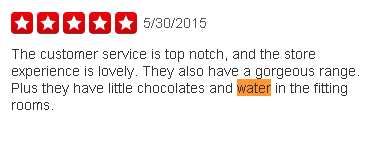 As a business owner in the retail industry, your worst fears are realized every day. The constant shifts in the trends and business models of the industry have you at the edge of your seat. If you aren’t on top of things, you may lose out to the hundreds of competitors who are at the ready to nab your customers. Even the mega-retail chains aren’t safe from these changing demographics and economics. You hear about more and more stores closing but, all this isn’t doom and gloom. When you take a closer look and add a little innovation to your business model, the constant evolution of the industry also presents you with an opportunity to invigorate your retail business and bring some much-needed attention towards it. But how can you do all that? There isn’t a simple formula for success here. Though, there are some interesting techniques that will help ease some of your fears and create a plan for the future of your business, so read on.
As a business owner in the retail industry, your worst fears are realized every day. The constant shifts in the trends and business models of the industry have you at the edge of your seat. If you aren’t on top of things, you may lose out to the hundreds of competitors who are at the ready to nab your customers. Even the mega-retail chains aren’t safe from these changing demographics and economics. You hear about more and more stores closing but, all this isn’t doom and gloom. When you take a closer look and add a little innovation to your business model, the constant evolution of the industry also presents you with an opportunity to invigorate your retail business and bring some much-needed attention towards it. But how can you do all that? There isn’t a simple formula for success here. Though, there are some interesting techniques that will help ease some of your fears and create a plan for the future of your business, so read on.1. Market to Consumer
Until quite recently, marketing to a group of individuals via TV or radio was simple, you created a message that was effective and presented your products to your consumers. But today, due to increased consumer demands, that style of marketing has become obsolete. Businesses in the retail industry need to engage their customers on a personal level. There are many avenues available to market your products in a personalized manner. Another aspect of this personal approach to marketing is to persuade your existing customers to recommend your business to their peers. Various retail industry statistics have proven that people are more likely to trust the advice of their peers than any promotional messages from a business.First tip experts offer up is simple:
While Instagram is a heavy visual marketing medium, retailers don’t have to spend thousands on photo shoots to create Instagram content because best photos come from fans and the influencers who love your products and brand.
A photo posted by birchbox (@birchbox) on Jan 13, 2016 at 7:25am PST
2. Think Big, Go Small
 Many business owners believe that the most important element in their retail business’s success will be the location
Many business owners believe that the most important element in their retail business’s success will be the locationand the scale of their store.
This approach will give you the flexibility of trying new ideas and techniques with your business without risking a lot.
There are some obvious advantages of a glitzy store at a prime location, but with more consumers diverting their attention toward e-commerce, you would benefit more with opening a small store and creating a prominent web presence.
The tips and insights:
In the Birchbox store, Beauchamp and Barna have sought to dismiss the traditional brick-and-mortar approach to beauty.
Instead of arranging products by brand, they chose to sort them by category, with entire sections of the shop dedicated to "Cheek" or "Lip” or “Brow."
Beauchamp is blunt about the appeal: “The reality is that 95 percent of all beauty products sold are still purchased offline. That means we spend a lot of our customers offline, to shop,” presumably at Birchbox competitors.
3. Offer an Experience
The amount of competition in the retail market demands that you create your own unique identity and separate yourself from the pack; your survival may depend on it. Offer unique products to your customers, and if you aren’t able to do that, then offer customers regular products in a unique way. Offer them a service or a deal that no other retailer will provide them with.
It can be as simple as offering the customer the convenience of customizing their clothes in the store itself or offer customers a refreshing drink when they walk in.

The possibilities are only limited by your own imagination, basically, anything that can add value to the experience of the customers should be on the table.
You also have to think beyond the initial sale.
Create opportunities for cross-sales and purchases. Put the customers in a situation where they can be influenced to make more purchases from the store. From product placement to offering the right package of products, you have to create a purchasing experience that offers value to your customers and helps you increase your sales numbers.
Integration of both the online and offline platforms for this purpose can be fruitful.
4. Be more Selective
To endure in the retail industry, your business needs to progress with the evolving customer demands, and it isn’t just about the choice of products you offer to them. Many big stores with a huge variety of products aren’t able to capture the attention of the consumers because that isn’t what they are looking for. You have to offer them the products that they are looking for. Online search data can help in this regard. Compile this data and present your customers with the products that they are looking for. This doesn’t necessarily mean that you have to only sell your products online. Use the internet as a platform to market your products and notify the consumers where they can buy the products they are looking for, although, having an online retail store will present a more fluid shopping experience to customers. The whole trick is to promote the products according to the customer type, give each consumer a personalized promotional message containing a product that s/he will be interested in.5. Take Lessons
Taking inspirations from other industries can help you learn crucial survival lessons. Take the fashion industry for example; there are new trends and buying patterns in the fashion industry every season. The businesses in the industry have learned to cope with their dynamic customer base and you can educate yourself by studying these businesses.Usually, you will see a fashion store changing its layout and merchandise on a regular basis. This is because their customers expect the latest offerings in the store and the business owners oblige by providing exactly that.In the retail industry, you can adopt a modified version of this technique by delivering products that fulfill the requirements of your customers. You will need some research data and in-depth analysis to discover exactly what those requirements are.